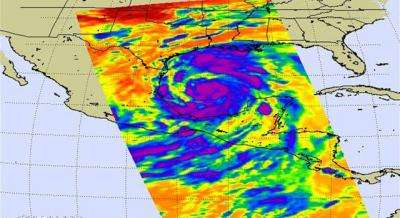Alex Stirs Up the Gulf

(PhysOrg.com) -- Tropical Storm Alex, soon to be a hurricane, churns its way through the western half of the Gulf of Mexico in this NASA infrared image taken Tuesday afternoon, June 29.
According to NOAA's National Hurricane Center, Alex is expected to approach the coast of northeast Mexico and southern Texas on Wed., June 30, and make landfall Wednesday night. The storm is expected to reach a peak intensity of 80 to 85 knots (92 to 98 miles per hour) before landfall, which would make it either a strong Category One or weak Category Two hurricane. Alex's tropical storm-force winds currently extend outward up to 175 miles (280 kilometers) from its center.
The storm is expected to produce total rainfall accumulations of 15 to 30 centimeters (6 to 12 inches) over parts of northeastern Mexico and southern Texas, with isolated amounts up to 51 centimeters (20 inches). A storm surge of about 1 to 1.5 meters (3 to 5 feet) above ground level is forecast along the immediate coast near and to the north of where Alex makes landfall.
The JPL-built and- managed Atmospheric Infrared Sounder (AIRS) instrument on NASA's Aqua satellite captured this infrared image of Tropical Storm Alex at 3:29 p.m. EDT (19:29 UTC) on June 29, 2010.
The AIRS data create an accurate 3-D map of atmospheric temperature, water vapor and clouds, all of which are helpful to forecasters. The image shows the temperature of Alex's cloud tops or the surface of Earth in cloud-free regions.
The coldest cloud-top temperatures appear in purple, indicating towering cold clouds and heavy precipitation.
The infrared signal of AIRS does not penetrate through clouds. Where there are no clouds, AIRS reads the infrared signal from the surface of the ocean waters, revealing warmer temperatures in orange and red.
Provided by JPL/NASA




















